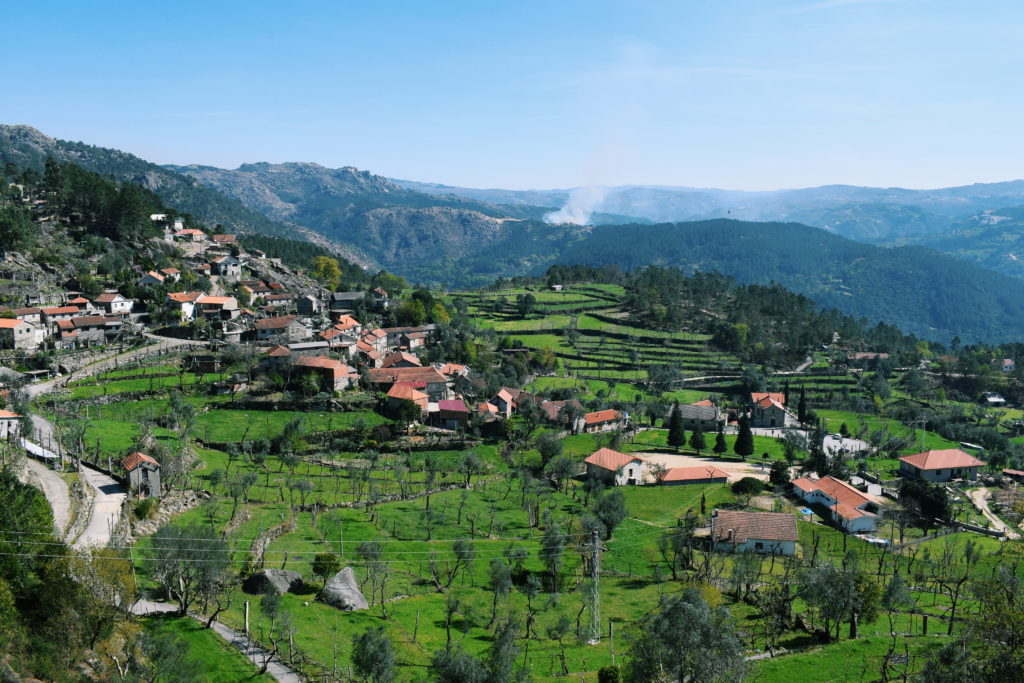Larger than life: visiting Peneda-Gerês National Park in Portugal
Author: Emma Higgins | April 26th 2017
Standing at Miradouro Pedra Bela, I can see the fresh green emerging from the landscape. Swathes of pine forests blanket the soaring granite hills, but in between these I spot lighter green foliage, dotted with yellow, new arrivals on these rocky hillsides. The sky is a hazy blue, ever so slightly covered in a cloudy lining, but the sun nevertheless shines through. It radiates a warmth that I tilt my face up towards to soak in.
In the depths of the valley below is Gerês village. The terracotta roofs of the houses stand out against the green and grey backdrop, and roads twist and turn between them. A red car trundles down one of these tracks and reaches the edge of the village before carrying on out into the wilderness. I watch it until it disappears behind a mound at the foot of the hills.
For the entire year I’ve been living in and travelling around Portugal, every local I’ve met has told me to visit Peneda-Gerês National Park, the only national park in the country. As I’ve mainly been based down in the Algarve, getting up to the far north of Portugal – where Gerês shares a border with Spain – has been a mission difficult to find the time for. However, as the final months of GKM’s year of adventures in Portugal have been creeping in, I knew it was about time I took the Portuguese people’s advice. I arrived in Gerês on the first day of spring.
Adriano was my driver for the day. A tall, lean man with silver hair, dressed in smart outdoor gear and talkative from the moment we shake hands, Adriano is exactly the kind of person you want to be guiding you around Peneda-Gerês. He works with Gerês Equi’Desafios, a company that specialises in outdoor activities in the park, including hiking, biking, canyoning, and horse riding. Pedra Bela is one of the first places Adriano takes me to, starting our whistle-stop tour of the best of Peneda-Gerês with a bang.
Made up of six glacial valleys, over 80,000 hectares, more than 90 villages, and with peaks soaring to 1,500m high, Pedra Bela is by no means the only magnificent viewpoint in Peneda-Gerês. The area was given national park status in 1971 with a view to protecting its unique scenery, dominated by four mountain ranges: Peneda, Soajo, Amarela and Gerês. Alongside the forests and flowers lining the trails here there’s an array of wildlife living in the park; it’s not unusual to come across wild horses, and wolves roam the land while eagles wheel through the skies.
We continue from Pedra Bela down into the valleys, snaking along the dirt tracks that cover the slopes. Adriano drops me off at Cascata do Arado, one of Peneda-Gerês’ many waterfalls. Early spring is the best time of year to witness these pockets of nature, when water is running down en masse from the tops of the mountains. The cascade here is certainly testament to the changing of seasons: a heavy stream tumbles over the stairways of rock, surrounded by lush greenery. The water at the bottom is a clear turquoise, and every now and then the sunlight catches the falls, throwing rainbows across the downpour.
Mother Nature might have the biggest presence in Gerês, but humans have also carved a place for themselves among the imposing landscape. One point that Adriano drives home as he leads me further around the park is the layout of the villages here. There are some collections of settlements in Peneda-Gerês, but also villages flung out into the middle of nowhere. If you consider the harsher climate up in the far north compared for further south in Portugal, it’s a bleak picture during the winter months for these isolated communities.
However, the people here have learnt to work with the land. Cattle are a big commodity and the farmers look after their stock well. Adriano points out pristine cattle sheds as we drive by them: “Look – these cows have a better house than me!” The larger communities have also built more facilities for tourists (who are mostly Portuguese) and school groups, making the most of the unique surrounding environment. These developments and the strengthening of the local area has not only enhanced Peneda-Gerês’ cultural identity – hardy, spirited rural living in Portugal – but also supported small local businesses that may have otherwise floundered.
We stop for lunch at Cantinho do Antigamente, a restaurant that serves traditional Portuguese fare. While we feast on cured pork and olives, rice and bean stew, pataniscas de bacalhau (salted cod fishcakes), and succulent cuts of beef still pink on the inside, Adriano tells me about the association behind this establishment. Started by two elderly nuns, the small collection of buildings includes a restaurant, a shop where you can buy handmade products – soaps, oils, and homewares – and a room for talks and school visits. This institution is a way for these people to share their unique way of living, showing the world what Peneda-Gerês is made of.
One of the novelties of visiting Peneda-Gerês is that you can pass from Portugal into Spain in the blink of an eye. Over the course of the afternoon, Adriano continues to drive me across the dramatic slopes, past beds of yellow flowering gorse and through villages made up of less than a dozen homes. Entranced by the landscape, I barely notice the Spain sign when we pass by it, and all of a sudden we’re gliding through Baixa Limia – Serra do Xurés in Galicia.
In terms of the landscape the two parks are very similar, of course, but the Spanish side is slightly more run-down. There is less money in this part of Spain than just over the border. As an example, property prices are significantly lower here compared to Portugal, sometimes by the tens of thousands. With these large differences in costs, it’s not uncommon to see many Portuguese coming up here to enjoy this part of the park. I notice all the P’s on car license plates as we arrive at the Lobios Caldaria thermal spa.
Northern Portugal is known for its healing natural hot springs, and the story is no different with neighbouring Spain. While you can visit the hot springs in Gerês village, the spas on the Spanish side have no sour smell and here next Lobios Caldaria you can take a dip in the outside pool. There are baths inside the 4* hotel, but just to one side of this building is an al fresco pool open to the public where you can take a dip in the sunshine.
Adriano and I find two dozen or so people submerged, some with their legs propped up on the sides and others lying on towels on the surrounding lawn. I walked up to the pool and crouched to dip my hand in and test the temperature – it was like a warm bath, the perfect heat for when the sun starts to sink behind the mountains that flank this scene.
We begin to return back to Gerês Equi’Desafios’ basecamp, back in Portugal and via an ancient Roman road. I almost felt like double checking with Adriano that we were even allowed to drive a vehicle down here; the track was narrow and seemed more like a walking path. It was like driving directly through a dense forest, with trees lining the way and their branches stretched out in a canvas above us. In the early evening light the sun shed an amber glow on everything in its path.
The Roman occupation of this land is still evident across Peneda-Gerês, especially on this road, also known as the Geira. Adriano paused on the trail many times to point out the landmarks placed here by these people thousands of years ago. The ingenuity of the Romans is made clear through these points; they show evidence of how they measured distance and used simple techniques to break through giant boulders for building. Green moss has taken resident across these signs of pre-historic life, but their presence is no less monumental.
In total, Adriano drove me 180km around Peneda-Gerês and its surroundings. The further we drove, the more I realised that this is much more than just a collection of mountains to marvel at. Whilst the domineering slopes are unarguably beguiling, Gerês also offers you the chance to experience how human life interacts with such colossal landscapes.
Through its timeless relics of civilisations gone, to rustic villages perched so steeply they look like they could slide right off the face of the planet, and the nature-hungry outdoor lovers that come here today, Gerês has cast people under its spell for millennia. It seems no wonder that this is Portugal’s only national park, a jewel in this country’s crown worthy of a closer look.
Have you thought of visiting Peneda-Gerês in Portugal?







Leave a Reply